You can use several different shapes to play diminished chords on guitar. Even though these chords are not used all that often in most genres, they can be quite impactful in the right situations. Let’s take a look at diminished chords and some of their unique characteristics.
What is a diminished chord?
A diminished chord in music consists of three notes–the root, flat 3rd, and flat 5th. Each note is a minor third from the next. A half diminished chord adds the flat 7th note. A Diminished 7th chord adds a doubled flatted 7th to the diminished triad.
As I said, there is a minor third interval between the first and second as well as the second and third notes of diminished triads. Technically the second note of the chord is called the minor 3rd. The third note of the chord is called the diminished 5th, and that’s where the diminished chord gets its name.
The harmonized major scale contains one diminished chord at the 7th scale degree. The three minor scales each have one or two diminished chords.
Not sure what the harmonized scales are? Read
Three types of diminished chords
Technically, a diminished chord is a triad. It has just three notes: the root, the flatted 3rd, and the flatted 5th. But you can easily extend the basic diminished chord in two interesting ways.
Quite often you’ll hear people refer to not only the diminished triad, but also either of the two variations as diminished chords. And in practical use, whenever a chord chart calls for a diminished chord, you could pretty much just as easily use one as the other. In fact, you can experiment to see which one you like best in any given situation.
Of course, some compositions will call specifically for one of the three diminished types and may not work properly if you substitute one of the others. You’ll have to make this determination.
The diminished triad
The diminished triad gives you the simplest diminished chord of all. As the name implies, it’s a three-note chord. Of course, theoretically you might play more than three strings on your guitar, but if the extra strings only repeat one of the basic chord notes in a different octave, it’s still technically a triad.
To easily find diminished chords on guitar, start with a minor chord. You might have noticed that a diminished triad is simply a minor triad with a flatted 5th. So, to find a diminished triad, start with any minor triad and lower the 5th by a fret.
For example, at fret 5, bar the G, B, and High E strings to play the notes C, E, and A. That’s the E-shaped A minor triad. To play the A diminished triad, just lower the E note at fret 5 of the B string to an Eb. Instead of using a bar for this, use your pointer at fret 4 of the B string for an Eb note, your middle finger at fret 5 of the G string for the C note, and your ring finger at fret 5 of the E string for the A note.

Those three notes–A, C, and Eb–make up an Adim triad. So the only difference between the two is the flatted 5th. The Eb instead of the E.
You might recognize the finger shape for the diminished triad as the same shape you use at fret 2 for an open D7 chord. In fact, if you make that shape at fret two and play the top four strings, you indeed have a D7. The addition of the D bass note makes it a D7. But if you leave the D note out and just play the top three strings, you have an F#dim chord.
I don’t know about you, but I find that kind of thing fascinating! The addition or omission of a single note, changes the chord drastically. It’s also cool to learn that you might already know a shape that you can use to play diminished chords on guitar immediately.
Also, this shape is completely moveable. You can move it up and down the neck to make any diminished triad you need.
In fact, keep that in mind as you make your way through this article because every shape that I discuss here is completely moveable.
Half diminished
Next, you can extend the basic diminished triad to create a half diminished chord. To do so, add the flatted 7th note of the scale to the basic diminished triad. You’ll often see these written in chord charts as Am7b5. In words, you’d say A minor seventh flat five.
This indicates how you can easily create a half diminished chord on guitar. First, start with a minor 7th chord and then flat the 5th degree.
Half diminished based on a Low E-string root
For instance, to play an Am7b5, we’ll start with an E-shaped Am chord at fret 5. With your pointer, bar across all the strings at fret 5. Use your ring finger to play fret 7 of the A string and your pinky fret 7 of the D string. That’s your E-shaped Am bar chord.
To turn that chord into an Am7, you need to add a note. That’s easy to do. Just lift your pinky and let the D string accept your bar at fret 5. Fret 5 of the D string is the note G. Now you have Am7.
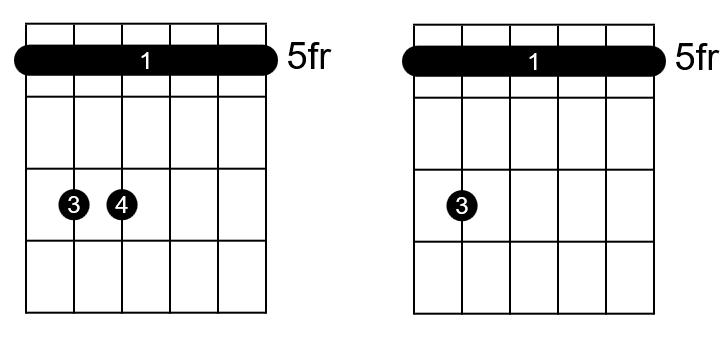
Now you just need to flat the 5th. To do that, move your ring finger down a fret. This is sort of an unnatural squeeze, so you might instead switch to your middle finger at fret 6 of the A string.
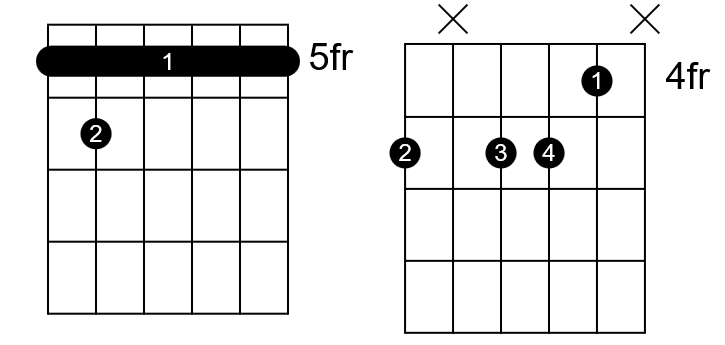
To play a four-note version of the A half diminished, you can switch the flatted 5th (the Eb note) to a different string. We’ll play that note on the B string.
Use your pointer to press fret 4 of the B string. This is your Eb note. The rest of the fingers play on fret 5. Your middle finger plays the A note on the Low E string. Let the flesh of your middle finger touch the A string without pushing it down. This “deadens” or mutes the sound of the A string so it doesn’t ring out. Use your ring finger on the D string and your pinky on the G string.
Half diminished based on an A-string root
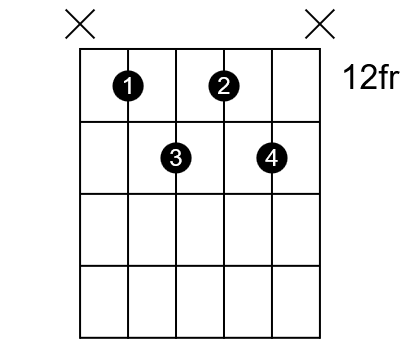
To play a half diminished chord with the bass note on the A string, we’ll play it much further up the neck.
Start with your pointer on the A note at fret 12 of the A string. Use your middle finger to play fret 12 of the D string. With your ring finger, play fret 13 of the D string. Finally, your pinky plays fret 13 of the B string.
This is actually quite a comfortable shape and it’s easy to get to once you know it. We’ll also shift this shape to different strings later to play a diminished 7th chord, so it’s a good shape to master. In fact, it’s my favorite shape for playing diminished chords on guitar.
Half diminished based on a D-string root
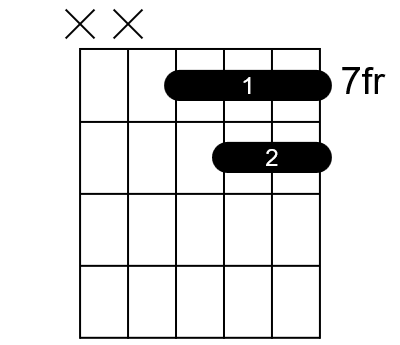
Another simple shape exists rooted on the D string. The easiest way for me to play this chord is to think of creating a double bar with my first and middle fingers.
First bar across the top four strings at fret 7 with your pointer. Then, bar at fret 8 across the top three strings with your middle finger.
Obviously since you’re baring one fret higher on the top three strings, the bar with your pointer isn’t technically necessary. But for me it’s the most comfortable way to play the chord. And the extra bar doesn’t hurt anything. But if your fingers bend in such a way that you can simply press that A note on the D string without baring the other strings, feel free!
Diminished 7th chords
Finally, the third type of diminished chord is the Diminished 7th chord. With this chord, you need to double flatten the 7th degree. Now you might say that if you double flatten the 7th, you’re playing the 6th. And you’d be right. But each degree of the scale has to be considered in naming the notes. And since the sixth is used already (by the 6th!), you have to call this note a double-flatted 7th.
Don’t get hung up on this quirk of theory. The point is that to create a dim7 chord, you take the 7th degree note and flatten it twice. On the guitar that means lowering the 7th by two frets.
Diminished 7th chords with a Low E string root
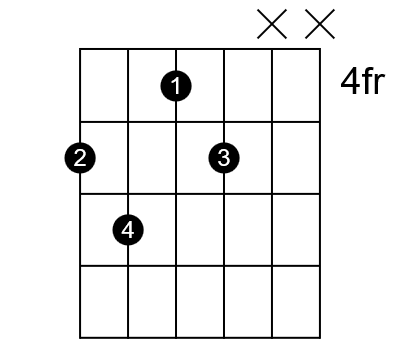
The Adim7 also has several possible shapes. To play it rooted on the E string, use your middle finger on fret 5 of the Low E string. With your pointer, play fret 4 of the D string. That note is Gb, and that’s your double flatted 7th. Use your ring finger at fret 5 of the G string for the flatted 3rd note, C. Finally, with your pinky on fret 6 of the A string you have Eb, your flatted 5th.
Diminished 7th chords with an A-string root
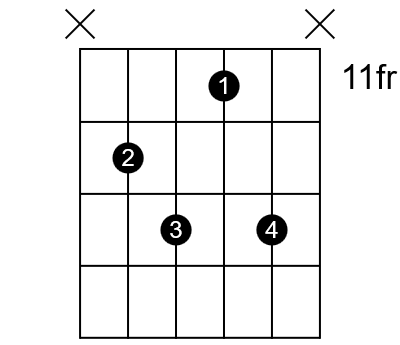
Again, you’ll need to find your root way up at the 12th fret for this shape in A. Use your middle finger to play the A root note at fret 12 of the A string. With your pointer, play fret 11 of the G string for your Gb. Your ring finger plays fret 13 on the D string for your Eb note. Finally, your pinky plays fret 13 on the B string for your C note.
This is another comfortable shape to play. Once you’ve learned it you can switch to it quickly, so it becomes a really useful shape to learn and get under your fingers reliably.
Diminished 7th chords with a D-string root
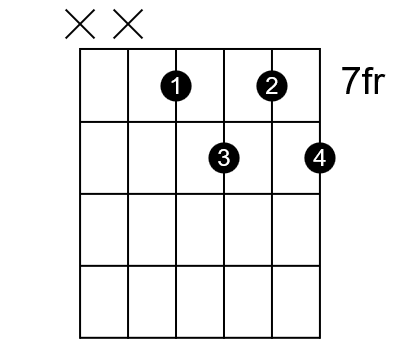
The last dim7 shape I’d like to talk about has been my favorite shape. Maybe that’s because it’s the first one I learned years ago. But it may also be because it’s so easy to play and get to. You already learned this shape earlier and I said you’d use it again. Here it is, but on different strings to make a dim7 chord.
Use your pointer to play the root note A on fret 7 of the D string. With your middle finger, play the Gb at fret 7 of the B string. Use your ring finger to play the Eb at fret 8 of the G string. Finally, with your pinky play fret 8 of the High E string to play the C.
This shape also really makes the chord cut through because it uses the four highest strings.
Special qualities of diminished 7th chords on guitar
If I have to choose, the diminished 7th chord is my favorite of the diminished chords on guitar. For one thing, it’s the most unsettled of all of these. It’s the flat 5 that gives the diminished triad and its extensions the tension and feeling of lack of resolve. When you add the flatted 7 of the half diminished chord you add another tense aspect.
But it’s that double-flatted 7th of the diminished 7th chord that really sets the listener on edge. Diminished chords exist to bring tension into music. And if you’re going in, I say go all in! The dim7 chord piles the tension on and sounds so interesting. That’s why I like it over the others.
And the dim7 has a couple of other really cool characteristics that make is a super-useful chord.
Every note is a root note
Because of the symmetrical structure of the diminished 7th chord, every note in the chord could be considered the root note. It kind of makes your head spin a bit!
The diminished triad, as you learned above, has two minor third intervals.
You have a minor third between the first note and the minor 3rd. And you have a minor third between the minor 3rd and the diminished 5th. When you add the double flatted 7th, you create yet another minor third interval between the diminished 5th and the double-flatted 7th.
Now, take this a step further. If you go one more minor third interval from there, you end up back on the root note.
So, it doesn’t matter which note of the dim7 shape you start on, if you keep jumping by minor third intervals, you’ll soon end up back on the root note one octave higher.
Let’s lay the notes out and see how it looks. We’ve been discussing our diminished chords on guitar in A. As we discovered, the notes of the Adim7 chord are:
A, C, Eb, Gb
Now let’s take each note of that chord and use it as the root note. The notes of the Cdim7 chord are:
C, Eb, Gb, A
And the notes of the Ebdim7 chord are:
Eb, Gb, A, C
Finally, the notes of the Gbdim7 chord are:
Gb, A, C, Eb
Pretty wild, right! So, if you know one shape in one position for a diminished 7th chord, you know them for three others automatically!
Inversions for diminished chords on guitar
Based on what I’ve just said above, you might have already made the connection that the Cdim7, Ebdim7, and Gbdim7 are inversions of those chords when played in the same position as the Adim7 chord with the A root as the lowest note.
So, it follows that if you move the shape so that you treat a different note as the root note, you’re playing different inversions of all four chords.
And here’s another really cool feature. Let’s say you want to play Adim7, but you want a different inversion than the one you learned with A as the lowest note. To do this, you only need to move the shape up three frets. Remember, three frets is a minor third.
So, when you move three frets up, you treat the next note in the chord as the lowest note. Let’s take A as an example again.
Play the D-string-rooted Adim7 shape. From low to high, the notes in the chord are A, Eb, Gb, C.
Now move the whole shape up three frets. From lowest to highest you now have the notes C, Gb, A, Eb. Same notes, different order. And that’s an inversion of the Adim7 chord.
Or, it’s a Cdim7 if you now treat the C note as the root.
And you could keep going. With a diminished 7th chord shape, you can move that shape up or down the neck by three frets and you’ll always have the same four notes in a different order, which gives you inversions. Very, very cool!
The use of diminished chords on guitar
So, now you know all about playing diminished chords on guitar. Well, to be honest, there are even more shapes you can use to play these chords, so you still have some discovery you could do on your own if you’re interested.
But you already know enough to use them in your songs. So, what role do they play? Why are they useful?
In reality, diminished chords are not used nearly as often as major and minor chords. As far as non-classical western music goes, you probably hear them more often in jazz than in any other genre. Still, they can be used in virtually any genre.
Diminished chords are full of tension
Diminished chords contain a huge amount of tension. They don’t feel settled or particularly comfortable. So, you’re not likely to land on a diminished chord for long. Instead, they’re most often used in a transitional role.
Because they create so much tension, diminished chords cry out to be resolved to a more comfortable chord, like a major or a minor chord.
Diminished chords play a transitional role
This reveals one of the coolest uses for these chords. You can almost always drop a diminished chord in between two other “comfortable” chords for a couple of beats. Sometimes even a couple of bars, though that’s not as common.
For instance, if you have a chord progression that moves from a major root chord (the I) to a minor 2nd chord (the ii), you could use a diminished chord to tie them together.
Say you’re in the key of A major. You want to move from the root A chord to the 2nd interval, which is a Bm chord. While you could easily jump from one to the other and it would sound great, you could use a diminished chord to make it sound even more great.
In this case you might play nearly two complete bars of A, but on the last beat you switch to a Bbdim7. After hitting that for one quick beat, you move into your Bm.
This creates a very cool tone leading sequence. The Bbdim7 sets up a whole bunch of tension that only gets resolved comfortably when you land on the Bm chord. And now your simple progression just got a whole lot more interesting.
It’s something your listener might not even realize happened. But your song is just that much more interesting because of the tension and resolve that you created with the addition of the dim7 chord.
You can really use this technique any time there is at least a whole step between the chord you’re on and the next chord in the progression. Stick a diminished 7th chord or a half diminished chord whose root note is a half step below the root of the chord you’re moving to and see how it adds life to your song by leading from the first chord into the target chord.
Experiment to find other cool uses
Of course, transitioning between two chords is just one use.
And as usual, there’s no law that says you can’t use diminished chords on guitar however you want to. Try them in unexpected places in your own playing or songwriting. You might find a cool way to make a diminished chord the featured chord of a verse or chorus.
The point is, while they are commonly used as transitional tools as I described above, you can use them for whatever you want to. If it sounds cool, it is cool!
Conclusion
Diminished chords on guitar bring an interesting aspect of tension and release into your playing.
The diminished triad consists of the I, bIII, and bV of the major scale. It’s the bV that causes all the tension in the triad.
You can add a bVII to the chord to create a half diminished chord. Or you can go all in and add a bbVII to really amp up the tension.
There are several different ways to play the half diminished and diminished seventh chords. You can root these chords on the E, A, or D strings for different sounds.
The diminished seventh chord has some very interesting characteristics that make it versatile and fun to use.
In the end, it’s the tension introduced by diminished chords that make them so interesting. You can use them to add another aspect to your playing.


This is a great write-up, Gary, and I love how you personalize it with your own preferences (and why). A couple of technical typos, though, in the second paragraph of the conclusion, where you refer to bIV when you mean bV.
You’re absolutely right, Larry! Thanks for catching those typos. I love it when readers are smarter than I am! I’ve corrected those to bV as you point out they should be. And thanks for the kind words about the article. It’s great encouragement to keep writing and teaching!
A great example of diminished chords being used as a bridge between 2 chords is George Harrison’s “My Sweet Lord”, coming out of the chorus and into the verse. This was super informative and clarified some foggy questions I’ve had.
Awesome example, Aaron! Thanks for pointing us to that. And thanks for the kind words. I’m glad you found the article helpful.
Very informative, thank you!
I believe there is a typo here: “You have a minor third between the first note and the minor 3rd. And you have a minor third between the minor 3rd and the diminished 5th. When you add the double flatted 7th, you create yet another minor third interval between the diminished 5th and the double-flatted 5th”
Should it be “double-flatted 7th”
You’re absolutely right, Paul! Yes, it’s should be “double-flatted 7th”. Thank you for spotting that. Sorry if I confused anyone. I’ve corrected it now. I’m glad you found the article helpful!